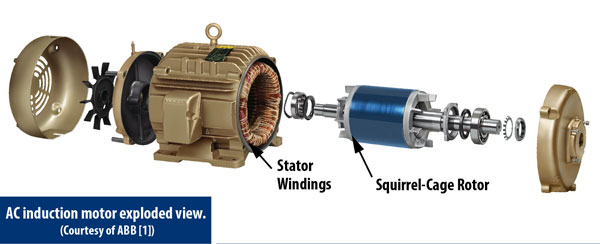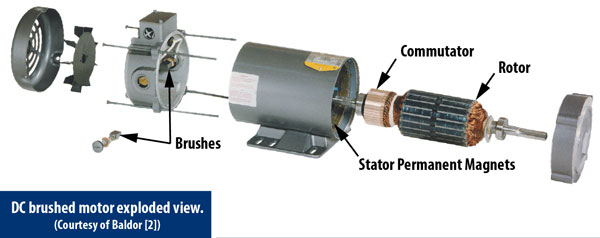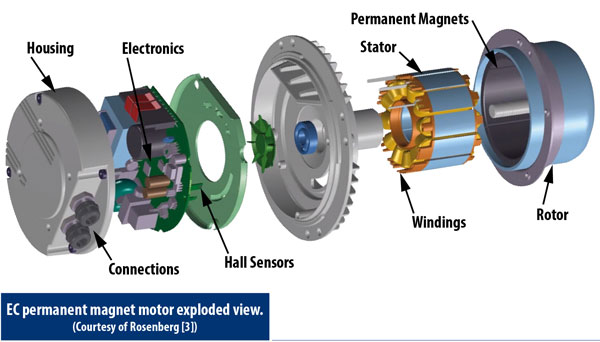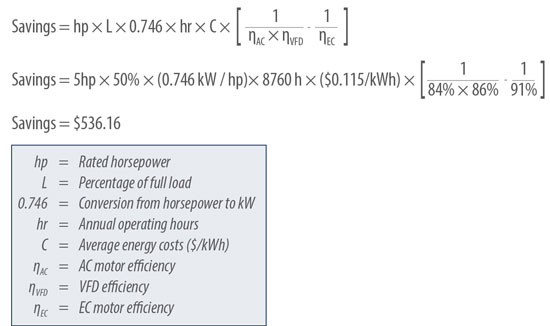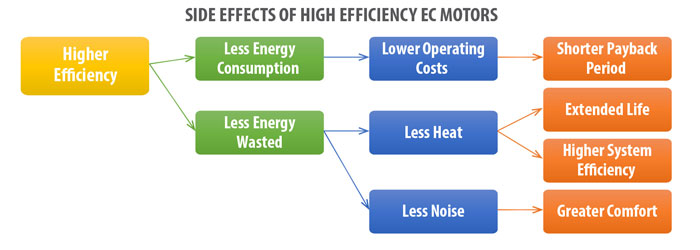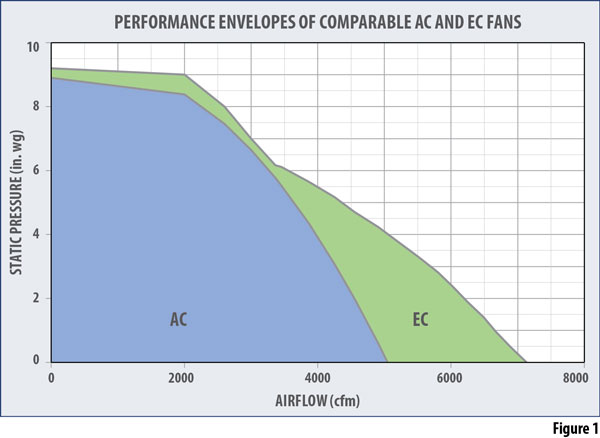What is an Electronically Commutated EC Motor?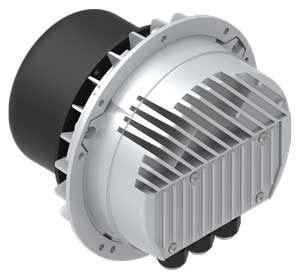 An electronically commutated (EC) motor is designed to run on an alternating current (AC) power supply, but it in fact bears a closer resemblance to a direct current (DC) motor. It is essentially a permanent magnet, brushless DC motor that incorporates on-board electronics. The added electronics allow an EC motor to combine the best features from both AC and DC motors, and then improve on them. For this reason, an EC motor is in a category of its own.
An electronically commutated (EC) motor is designed to run on an alternating current (AC) power supply, but it in fact bears a closer resemblance to a direct current (DC) motor. It is essentially a permanent magnet, brushless DC motor that incorporates on-board electronics. The added electronics allow an EC motor to combine the best features from both AC and DC motors, and then improve on them. For this reason, an EC motor is in a category of its own.
By utilizing this technology, EC fans are highly efficient and pay for themselves through lower operating costs and extended service life. They also provide many operational benefits that are often overlooked. Once these attributes are fully recognized in North America, EC fans will become the next revolution in the air movement industry.
Motor Design
Internal vs. External Rotor
Motors come in a wide range of shapes and sizes, with the conventional style being the internal rotor configuration.
Internal rotor motors are designed with the stator (stationary component) fixed to the motor housing. The rotor (rotating component) is located inside the stator and transmits torque through the output shaft. A fan impeller is typically attached to the rotating shaft.
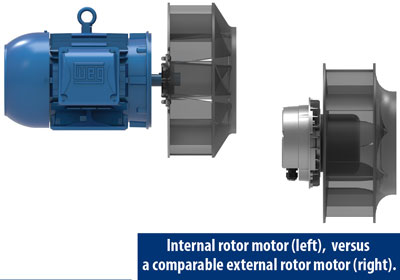
External rotor motors essentially have the opposite orientation, with the rotor rotating on the outside of the stator. This eliminates the need for an output shaft and greatly reduces the overall footprint of the motor and impeller assembly. A fan impeller can be attached directly to the external rotor, effectively creating a motorized impeller.
AC vs. DC vs. EC
All electric motors serve the same function of converting electrical energy into mechanical energy, but they accomplish this in different ways. The method used depends mainly on the power supplied to the motor, as this affects the way their magnetic fields are created and controlled. For this reason, motors are often categorized as being AC, DC, or EC. In the fan industry, common types of each include the AC induction motor, DC brushed motor, and EC permanent magnet motor.
AC induction motors have electrical windings in the stator that are supplied with alternating current to produce a rotating magnetic field. The stator field induces a current in the conductive squirrel-cage rotor, and the interaction between the two magnetic fields produces torque on the rotor.
With a fixed line frequency, AC motors have a limited speed range, so they are designed to operate at the peak efficiency point on their performance curve. Outside of this range, efficiency tends to drop off significantly. A variable frequency drive (VFD) can be used to increase or decrease the frequency of the AC supply, but they tend to be quite bulky and expensive. That is why AC motors are best suited to applications where variable speed is not required.
DC brushed motors use permanent magnets in the stator to provide a fixed magnetic field. Electrical windings in the rotor are voltage induced and influenced by the stator’s magnetic field. Changing the power supply voltage allows DC motors to be speed controlled much easier than AC motors.
Since they run on direct current, they rely on carbon brushes and a commutator ring to switch the current direction. Wear and tear on these mechanical components can contribute to more operational noise and a shorter life expectancy. Furthermore, DC power supplies aren’t as prevalent as they used to be, so acquiring a stand-alone AC to DC rectifier means added cost and complexity.
EC motors use permanent magnets and electrical windings to generate their magnetic fields, in a similar fashion to brushed DC motors. However, as their name suggests, they achieve commutation electronically rather than mechanically. This is only possible by incorporating on-board electronics within the housing of an electronically commutated EC motor.
The on-board electronics include a rectifier that converts the AC supply to DC. An integrated controller then directs the right amount of current, in the right direction, at the right time, through each of the windings. This develops magnetic poles in the stator, which interact with the permanent magnets in the rotor.
The position of each magnet is determined by using Hall effect sensors. The appropriate magnets are attracted, in sequence, to the magnetic poles in the stator. Simultaneously, the rest of the stator windings are charged with the reverse polarity. These attraction and repulsion forces combine to achieve rotation and produce the optimal torque. Since this is all done electronically, precise motor monitoring and control are possible.
Advantages of an Electronically Commutated EC Motor
Energy Efficiency
Electronically commutated EC motor efficiency is often above 90%, allowing EC fans to consume up to 70% less energy, when compared to conventional fans.
By adjusting an EC motor’s speed to match the demand, the potential for energy savings continues to grow. Shown below, are the typical efficiencies for a 5 HP, 1800 RPM AC induction motor and an equivalent EC motor.
Even when compared to on/off operation, the speed modulation offered by EC fans is more efficient. For example, running an EC fan 80% of the time saves 20% of the energy, while running it at 80% speed saves nearly 50% of the energy. This is only possible with EC technology, which offers very high efficiency across a range of speeds.
The most obvious benefit of high efficiency is lowered energy consumption. With rising energy prices, this is a crucial factor to consider.
To outline the importance, an energy savings example at 50% speed has been worked out below. This example assumes an average cost of $0.115/kWh, a variable frequency drive (VFD) efficiency of 86%, and continuous motor operation.
While the annual savings seem negligible, it must be noted that this is for a single fan replacement and doesn’t account for other losses, such as line or belt. Another factor to consider, aside from the lower operating costs, is utility rebates that may be available.
High efficiency also leads to a range of secondary and tertiary benefits, outlined in the diagram below.
A benefit of high efficiency is less energy losses to the environment. These losses are typically in the form of heat and sound.
Since EC motors produce less heat, their windings and bearings undergo less stress, which extends the life of the motor. The lower operating temperatures also contribute to higher system efficiencies, when used in cooling applications. Meanwhile, the quieter operation results in increased occupant comfort.
Ease of Control
The high efficiency of EC motors can largely be attributed to the integrated electronics. By continuously monitoring motor functions and automatically adjusting the control input, high efficiency is maintained throughout the operable speed range. EC motors are often capable of being turned down to 20% of full speed, while still maintaining 85% efficiency.
Sensors that produce a 0-10 V, PWM, or 4-20 mA signal can be connected directly to most EC motors. This provides speed control without the need for a complex variable frequency drive (VFD).
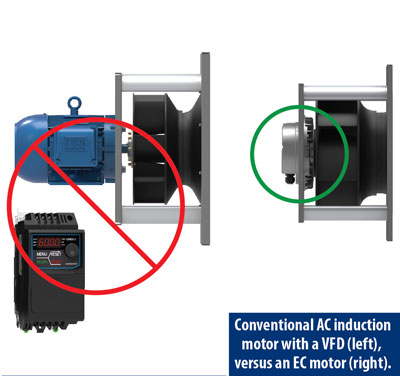 There are both open loop and closed loop control methods that can be implemented, depending on the application. Fans with electronically commutated EC motors can control temperature, pressure or whichever parameter is chosen to be measured. Constant pressure control is particularly useful for ducted applications, while constant airflow control is ideal for filtered applications. Alternatively, a potentiometer can be connected to provide a manual form of variable speed control.
There are both open loop and closed loop control methods that can be implemented, depending on the application. Fans with electronically commutated EC motors can control temperature, pressure or whichever parameter is chosen to be measured. Constant pressure control is particularly useful for ducted applications, while constant airflow control is ideal for filtered applications. Alternatively, a potentiometer can be connected to provide a manual form of variable speed control.
Versatility
The maximum speed of conventional AC induction motors is limited to a standard rating, called the synchronous speed. This is a theoretical speed based on the number of electromagnetic poles and the frequency of the power supply.
On the other hand, EC motors are capable of exceeding rated speeds. This allows fans with EC motors to achieve higher capacity within a smaller fan package, as shown below in Figure 1. The larger operating envelope of EC fans enables them to easily match performance for a given application. The combination of high capacity and an EC motor’s ability to maintain efficiency at partial load, makes it possible for one EC fan to replace multiple types and sizes of conventional fans.
There are numerous applications that provide cost-effective opportunities to adopt fans with EC motors. Ventilation systems represent an excellent opportunity for two main reasons:
- Ventilation fans commonly require fractional horsepower, and they are often driven by inexpensive and very inefficient motors.
- Many fixed-speed ventilation fans employ intermittent operation, which represents a chance to use EC motors running at reduced speeds.
EC fans are also a highly recommended upgrade for air handling units. They can achieve a more uniform temperature distribution with their speed control. In many cases, they can be continuously run at partial speed and still provide a decrease in utility bills. Continuous circulation provides even distribution of fresh air and temperatures. Thus, fans with EC motors help to promote better circulation, comfort and health.
Since EC motors are highly efficient, less energy is dissipated in the form of heat. This makes EC fans very appealing for cooling applications because it reduces a system’s load. High efficiency also means that less energy is lost in the form of sound, allowing EC fans to operate quieter.
Why Choose an EC Fan?
The benefits of EC fans are clear, so the decision to upgrade often comes down to the payback period. This can only be determined after an analysis has been completed by a professional energy consultant. The financial benefit of an EC fan upgrade needs to be evaluated on a case-by-case basis. However, the following results can generally be expected:
- The lower the efficiency of the fan being replaced, the faster the payback period will be.
- Replacing fans that are used frequently will provide higher savings than upgrading fans that are only used moderately.
- EC fans are an attractive option for applications that require speed control. Other types of motors suffer a drastic reduction in efficiency at partial speeds.
- The energy savings are higher when fans with EC motors are deployed in air-conditioned or refrigerated spaces.
EC technology combines the advantages of AC and DC motors within a compact, yet versatile, package. The integrated electronics ensure optimal efficiency, even at partial load, which represents a significant opportunity to save on operating costs. Implementing one of the built-in control methods is the best way to take full advantage of all the benefits that EC fans provide.
CFM Fans with Electronically Commutated EC Motors
Continental Fan has an extensive selection of motorized impellers that feature EC motors. By utilizing this advanced technology, our EC Fans have achieved new standards for energy savings and performance.

The above EC fans are available in various sizes and speeds to cover a wide range of operating points. They are also available in different materials and voltages to suit a variety of applications.
For more information, visit the CENTRIFUGAL & AXIAL EC FANS section of our website.
Download a PDF copy of our EC Motors & Fan Applications today!
Sources
[1] ABB, “NEMA Super-E® Premium efficient motors,” abb.com, October 2014. [Online].
Available: https://library.e.abb.com/public/e35d57ce4df3160285257d6d00720f51/9AKK106369_SuperE_1014_WEB.pdf. [Accessed August 2, 2019].
[2] Baldor, “Direct Current Motors and Drives 1/50 – 3000 Hp,” baldor.com, May 2013. [Online].
Available: https://www.baldor.com/mvc/DownloadCenter/Files/BR600. [Accessed August 2, 2019].
[3] Rosenberg, “Rosenberg’s EC Motor Construction,” youtube.com, January 2017. [Online]. Available: https://www.youtube.com/watch?v=4LeTePGMyrE. [Accessed August 2, 2019]

